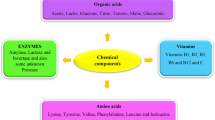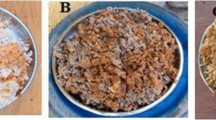Abstract
The objective of this study was to prepare low-alcoholic takju. Low-alcohol (3.06%) and dealcoholized (0.04–0.28%) takju samples were prepared by adopting bentonite clarification, heat and reverse osmosis treatments. The dealcoholization of takju, in most cases, significantly (p < 0.05) reduced the total mineral (from 505.80 to 258.61 mg/L), free amino acid (from 989.81 to 293.58 mg/mL), antioxidant potentials and total phenolic (from 345.30 to 156.30 µg GAE/mL) contents remained in the control to RO-3 (takju sample obtained from 3-time reverse osmosis and heat treatment). Similarly, the content of volatile compounds was also significantly (p < 0.05) decreased with the dealcoholization treatments. The finding of this study clearly showed that dealcoholized takju could be prepared but at the expense of reduced nutritional and antioxidant potentials. This study could be an exemplary in promoting traditional beverages in different countries by producing low or alcohol-free drinks.
Similar content being viewed by others
References
Armada L, Falqué E. Repercussion of the clarification treatments agents before the alcoholic fermentation on volatile composition of white wines. Eur. Food Res. Technol. 225: 553–558 (2007)
Blois MS. Antioxidant determinations by the use of a stable free radical. Nature 181: 1199–1200 (1958)
Brányik T, Silva DP, Baszczynňski M, Lehnert R, Almeida e Silva JB. A review of methods of low alcohol and alcohol-free beer production. J. Food Eng. 108: 493–506 (2012)
Burin VM, Caliari V, Bordignon-Luiz MT. Nitrogen compounds in must and volatile profile of white wine: influence of clarification process before alcoholic fermentation. Food Chem. 202: 417–425 (2016)
Catarino M, Mendes A, Madeira LM, Ferreira A. Alcohol removal from beer by reverse osmosis. Sep. Sci. Technol. 42: 3011–3027 (2007)
Chung SK, Osawa T, Kawakishi S. Hydroxyl radical scavenging effects of spices and scavengers from Brown Mustard (Brassica nigra). Biosci. Biotechnol. Biochem. 61: 118–123 (1997)
Diban N, Athes V, Bes M, Souchon I. Ethanol and aroma compounds transfer study for partial dealcoholization of wine using membrane contactor. J. Membr. Sci. 311: 136–146 (2008)
Gil M, Estevez S, Kontoudakis N, Fort F, Canals JM, Zamora F. Influence of partial dealcoholization by reverse osmosis on red wine composition and sensory characteristics. Eur. Food Res. Technol. 237: 481–488 (2013)
He YY, Pen MA, Liu XL, Wang RH, Wei LU. Effect of different initial pH on the storage characteristics and shelf life of liquid diet for suckling and weanling piglets. J. Integr. Agric. 13: 134–139 (2014)
Houston MC, Harper KJ. Potassium, magnesium, and calcium: their role in both the cause and treatment of hypertension. J. Clin. Hypertens. 10: 3–11 (2008)
Howard KL, Mike JH, Riesen R. Validation of a solid-phase microextraction method for headspace analysis of wine aroma components. Am. J. Enol. Vitic. 56: 37–45 (2005)
Je JY, Park PJ, Jung WK, Kim SK. Amino acid changes in fermented oyster (Crassostrea gigas) sauce with different fermentation periods. Food Chem. 91: 15–18 (2005)
KFCT. Korean Food Composition Table 7th ed. Rural Resources Development Institute, Rural Development Administration, Suwon, Korea (2006)
Kim I-D, Lee J-W, Kim S-J, Cho J-W, Dhungana SK, Lim Y-S, Shin D-H. Exogenous application of natural extracts of persimmon (Diospyros kaki Thunb.) can help in maintaining nutritional and mineral composition of dried persimmon. Afr. J. Biotechnol. 13: 2231–2239 (2014)
Kucera J. Reverse osmosis principles. pp.15–19. In: Reverse Osmosis: Design, Processes, and Applications for Engineers. Kucera J (ed). Wiley, Hoboken, NJ, USA (2015)
Lee S, Lee JA, Park GG, Jang JK, Park YS. Semi-continuous fermentation of onion vinegar and its functional properties. Molecules 22: 1313 (2017)
Li X. Improved pyrogallol autoxidation method: a reliable and cheap superoxide-scavenging assay suitable for all antioxidants. J. Agric. Food Chem. 60: 6418–6424 (2012)
Liguori L, Russo P, Albanese D, Di Matteo M. Evolution of quality parameters during red wine dealcoholization by osmotic distillation. Food Chem. 140: 68–75 (2013)
Mira H, de Pinho MN, Guiomar A, Geraldes V. Membrane processing of grape must for control of the alcohol content in fermented beverages. J. Membr. Sci. Res. 3: 308–312 (2017)
Mitić SS, Paunović DĐ, Pavlović AN, Tošić SB, Stojković MB, Mitić MN. Phenolic profiles and total antioxidant capacity of marketed beers in Serbia. Int. J. Food Prop. 17: 908-922 (2014)
Monnot M, Nguyen B, Zaviska F, Lesage G, Héran M. Performance of nanofiltration and reverse osmosis after membrane bioreactor for urban source-separated urine treatment and water reuse. Desalin. Water Treat. 95: 18–33 (2017)
Nicolini G, Larcher R, Pangrazzi P, Bontempo L. Changes in the contents of micro-and trace-elements in wine due to winemaking treatments. Vitis 43: 41–45 (2004)
Ough CS, Amerine MA. Methods for Analysis of Musts and Wines. Wiley, New York, USA. pp. 80–107 (1988)
Oyaizu M. Studies on products of browning reaction: anti-oxidative activity of products of browning reaction prepared from glucosamine. Jpn. J. Nutr. 44: 307–315 (1986)
Ribéreau-Gayon P, Dubourdieu D, Donéche B, Lonvaud A. Handbook of Enology: The Chemistry of Wine Stabilization and Treatments. 2nd ed. Wiley, Chichester, UK (2006)
Sanborn M, Edwards CG, Ross CF. Impact of fining on chemical and sensory properties of Washington State Chardonnay and Gewürztraminer wines. Am. J. Enol. Vitic. 61: 31–41 (2010)
Singleton V, Orthofer R, Lamuela-Raventos R. Analysis of total phenols and other oxidation substrates and antioxidants by means of Folin–Ciocalteu reagent. pp. 152–178. In: Oxidants and Antioxidants. Packer L (ed). Academic Press, New York, NY, USA (1999)
Skujins S. Handbook for ICP-AES (Varian-Vista). A short Guide to Vista Series ICP-AES Operation. Varian Int. AG, Zug, Version 1.0. Switzerland Society of Food Science and Technology 29: 221–227 (1998)
Souza AL, Pagani MM, Dornier M, Gomes FS, Tonon RV, Cabral LM. Concentration of camu–camu juice by the coupling of reverse osmosis and osmotic evaporation processes. J. Food Eng. 119: 7–12 (2013)
Tyagi T, Agarwal M. Antioxidant properties and phenolic compounds in methanolic extracts of Eichhornia crassipes. Res. J. Phytochem. 11: 85–89 (2017)
Villaño D, Fernández-Pachón MS, Troncoso AM, García-Parrilla MC. Influence of enological practices on the antioxidant activity of wines. Food Chem. 95: 394–404 (2006)
Voilley A, Lamer C, Dubois P, Feuillat M. Influence of macromolecules and treatments on the behavior of aroma compounds in a model wine. J. Agric. Food Chem. 8: 248–251 (1990)
Wang YF, Wang XY. Binding, stability, and antioxidant activity of quercetin with soy protein isolate particles. Food Chem. 188: 24–29 (2015)
Wenten IG, Khoiruddin. Reverse osmosis applications: Prospect and challenges. Desalination 391: 112–125 (2016)
Yildirim HK. Effects of fining agents on antioxidant capacity of red wines. J. Inst. Brew. 117: 55–60 (2011)
Author information
Authors and Affiliations
Corresponding author
Ethics declarations
Conflict of interest
The authors declare that they have no conflict of interest.
Additional information
Publisher's Note
Springer Nature remains neutral with regard to jurisdictional claims in published maps and institutional affiliations.
Rights and permissions
About this article
Cite this article
Kim, ID., Dhungana, S.K., Park, YS. et al. Dealcoholization of Korean traditional rice wine, takju, combining thermal, bentonite clarification or reverse osmosis treatment. Food Sci Biotechnol 28, 1421–1431 (2019). https://doi.org/10.1007/s10068-019-00574-z
Received:
Revised:
Accepted:
Published:
Issue Date:
DOI: https://doi.org/10.1007/s10068-019-00574-z




